Softproof means: The correct color display of a printed product on a monitor. Both a standardized print, e.g. according to process standard offset printing, can be simulated – e.g. a later offset print according to ISOCoatedV2 can be simulated correctly in colour on the screen – and the output on digital terminals such as LFP systems in advertising technology.
From a technical point of view, soft proofs are now well controllable. The monitor technology is advanced enough to provide excellent displays with a high color gamut and consistent illumination even for a few hundred euros. For example, monitors in two branches of a company can be coordinated in such a way that the result displayed on the monitors corresponds exactly to each other at both locations, i.e. one image editor in Hamburg and one in Munich can talk about retouching the same file.
The problem: The fact that the two monitors emit the identical color and light result can be precisely controlled. The fact that the colleague in Hamburg is looking at the foggy Alster lake at a northern window, while the colleague in Munich moved the monitor to a southern window in the direction of the Isar river in sunshine, already shows the problem: The environment variables under which the softproof is viewed are not identical.
It is even more difficult when the soft proof is to be used in the pressroom to coordinate the production run. Many companies such as JUST offer modern solutions that can provide a soft proof directly at the press. However, the problem remains that the soft proof should be considered to be less than 10% away of the brightness of the press. While 2000 lux brightness was previously the standard for printers, JUST now writes: “The comparison of soft proofs on monitors with prints and hard proofs is regulated in accordance with ISO 12646. The light conditions basically correspond to ISO 3664, but the brightness must be adjusted to the limited luminance of the monitor, which ideally is > 120 cd/m². ”
Two scenarios therefore arise at the printing press: Either the printer is “in the light” and can then match the print with a contract proof printed on paper, or it is “in the dark” and can match the print with the soft proof. The difficulty of matching paper and monitor – and these are two completely different and difficult to compare media – is compounded by the difficulty of the printer having to dim the light at the press by up to a factor of 10 to be able to match both a contract proof and a soft proof at the same workstation. From today’s point of view, this does not really seem practicable.
Conclusion: The soft proof is on the advance and will certainly sooner or later displace the classic contract proof from the market for reasons of speed and cost. However, due to the great technical lighting and haptic differences between the monitor and the illuminated sheet of paper, a widespread introduction is still a long way off. After all, anyone who has ever performed a color match on a printing press can imagine that a match to the contract proof on the one hand and to a soft proof monitor on the other hand is difficult to imagine at the same time. The contract proof will therefore also have to remain the first choice in the near future in order to be able to carry out colour-accurate proofing of the printing result in the pressroom.

From now on you can conveniently order proofs at shop.proof.de: At shop.proof.de is available under shop.proof.de a comfortable online shop with numerous benefits available: Convenient Data Upload: Each item one or more files can now be uploaded. So you can assign your data directly to the individual proofs. Payment by Paypal, direct debit, invoice etc .: You are on shop.proof.de with Paypal and direct debit payment methods more available. Of course you can continue to conveniently order proofs on invoice. See Previous orders, invoices, data uploads: You can always check your … read more

Especially in larger companies today the layout in RGB is the rule rather than the exception. The advantages are obvious: In practice, however, there are two potential problems in particular. Problem 1: CMYK conversion in the last step.The catalogue is designed in InDesign, all data is perfectly matched, the last step before printing and proofing is the export to a printable PDF in CMYK. Usually this is done via a preset in InDesign, which defines the exact specifications for the color space conversion. In practice, however, this color space transfer … read more

The Proof GmbH provides proofs for Scheufelen Heaven 42 papers on the new EFI 8245 OBA proofing paper. With this new proofing paper it is now possible to proof the bright-white paper dye of Heaven42l. With Heaven 42 a bright white paper was developed by the German paper company Scheufelen, which opened up a new color whiteness. Especially technical motifs (shades of gray, silver tones from 4c, strong contrasts) act on Heaven 42 particularly brilliant and neutral. With an unchanged separation (eg with ICC profile “ISOcoated_v2”), but the printed image with the … read more

In this short image video we – the Proof GmbH – introduce us and our work. Find out who we are and what drives us. What do you think of our short film?

EAN codes are standard on every product today. While in the good old days, shopowners themselves typed the prices into a cash register by hand, today scanner cash registers are the rule, which scan standardized EAN codes with a laser and thus clearly recognize the article and add it to the receipt. EAN, by the way, stands for “European Article Number” and was replaced in 2009 by the global GTIN, “Global Trade Item Number”. The EAN or GTIN is a barcode that can be read automatically and read by barcode … read more

“We print 135gr/sqm on a Berberich Allegro. Can you make us a proof on this paper? Can you proof on our final production paper?” Our telephone support often asks for a proof on production paper. Unfortunately, we always have to answer the question negatively. I would like to briefly explain the reasons for this in the following article. Proofing on production paper is still technically impossible. All proofing systems currently certified by Fogra are based on an inkjet printer as a test printer, mostly from Epson, Canon or HP. These … read more

Requests such as the proof of a printed tin can often reach us. Why can’t such a printed can be “proofed”? A proof is a standardized product. Take the classic ISOCoatedV2 proof, for example; the standard proof for coated printing paper. Here is the definition in brief: “Paper type 1 and 2, glossy and matt coated paper, dot gain curves A (CMY) and B (K) from ISO 12647-2:2004” (Source: farbproofs.de) Metal is printed with a varnish. Neither the colour of the metal of the tin can nor the colour of … read more

Offset and Newsprint ISO Coated v2 (ECI) / ISO Coated v2 300% (ECI) Profile: ISOcoated_v2_eci.icc Standard for glossy and matte coated paper Paper: Types 1 and 2, gloss and matte coated Tone value increase curves A (CMY) and B (K) as defined in ISO 12647-2:2004 Characterisation Data: FOGRA39L ISOUncoated Profile: ISOUncoated.icc Standard for uncoated white natural paper Paper: paper grade 4, uncoated white offset, dot gain curves C (CMY) and D (K) from ISO 12647-2: 2004 Characterisation Data: FOGRA29L PSOCoatedV3 / Fogra 51 Profile: PSOcoated_v3.icc The successor of ISOCoatedV2 for glossy … read more

Digimarc is a digital watermark that can be used to embed information in images, videos or other media. Digimarc watermarks are invisible to the human eye, but remain recognisable to special software or devices. Digimarc is becoming increasingly popular in the packaging sector in particular, as this technology allows the digits of the EAN barcode and more to be applied invisibly to all areas of the packaging. Digimarc and EAN barcode at the supermarket checkout When scanning at the checkout, the checkout staff do not have to search for the … read more

Customers are often unsettled when they hold a proof in their hands. “The proof of the picture is much darker than the picture on my monitor. Why is that so? And what do I do now?” There are many possible reasons for a deviation between the proof and, for example, the monitor display: The monitor is not calibrated Only calibrated monitors can accurately display color. When I buy a cheap monitor and connect it to my computer, I definitely can’t see any real color. As a rule of thumb, only … read more






Das stimmt, ich habe gesehen, daß Quato mit dem Proof View 700 – 42 Monitore hat, die speziell auf den Leitstand bzw. die Normlichtkabine ausgerichtet sind und mit Luminanzen von bis zu 700 cd/qm glänzen sollen, das hieße laut meinen Erfahrungen auch eine reale Leuchtdichte von 450 cd/qm.
Kennen Sie denn den Monitor im Einsatz aus der Praxis? Für ISOCoatedV2 scheint das ja wirklich noch nicht zu funktionieren. Und ist LWC tatsächlich im Rahmen des Farbumfanges erreichbar? Ich habe das Gerät noch nie im Einsatz gesehen und gemessen.
Grundsätzlich stimme ich Ihrer Einschätzung zu. Die Kontrolle und Stabiliät der Umgebungsparameter sind auch meiner Meinung nach der Schlüssel zum “perfekten Softproof”…
Ich möchte allerdings das Zitat der Firma JUST und den genanten Luminanzwert von “…idealerweise >120cd/m²” noch etwas besser einordnen und das beschriebene “Horrorszenario” etwas entschärfen:
Aktuelle Softproof-Monitore können heute durchaus über den Zeitraum von >2 Jahren eine Luminanz von bis zu 200cd/m² stabil leisten, so dass die Leitstandsbeleuchtung auf lediglich ~700 Lux (also grob einem Drittel) reduziert werden muss. Das ist zwar immer noch gewöhnungsbedürftig, aber durchaus praktikabel und wird auch so in der Produktion schon heute angewandt.
Von QUATO gibt es zudem einen 42″-Proof-Monitor, welcher sogar dauerhaft mit einer Leuchtdichte von 450cd/m² betrieben werden kann und somit die Beleuchtung des Druckleitstandes lediglich um ~500Lux reduziert werden muss, so dass man sich weiterhin innerhalb des ISO-Standard (2000 Lux +/- 500Lux) befindet.
Leider kann dieser Monitor nicht den vollen Farbumfang der Druckbedingung ISOcoated v2/FOGRA39 darstellen. Im Zeitungsdruck z.B. sind hiermit aber schon heute problemlos ISO-konforme Produktionsbedingungen, kombiniert mit den Vorteilen des Softproof, möglich.